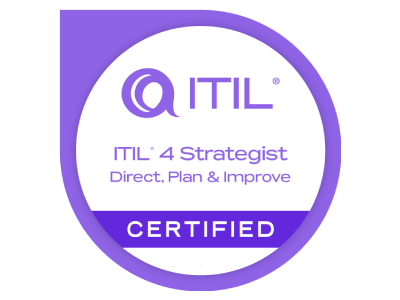ITIL® 4 Strategist: Direct, Plan, and Improve
Acquire the practical abilities required to establish an IT organization that is “learning and improving” and has a solid and successful strategic direction. Understanding the effects of Agile and Lean work processes and how to use them to an organization’s benefit is made easier with the ITIL® 4 Strategist (Direct, Plan, and Improve) training.
Overview
The ITIL® 4 Strategist: Direct, Plan, and Improve (DPI) training course provides participants with an in-depth understanding of how to develop and implement effective IT strategies and improve IT services. This module focuses on strategy development and execution and is designed to enable individuals and organizations to plan and implement effective strategies that support business objectives. Participants will learn about the principles and practices of strategic planning, governance, and risk management, as well as the tools and techniques for measuring and improving service performance.
What Skills Covered in ITIL® 4 Strategist: Direct, Plan, and Improve Course?
- Operating Model
- Governance compliance mgt
- Optimization of workflow
- Strategy tactics operations
- Risk management in DPI
- Value stream mapping
Who should take up this ITIL® 4 Strategist: Direct, Plan, and Improve Course?
- IT Managers and Directors
- ITIL Practitioners and Service Managers
- IT Consultants and Service Providers
- Quality Analysts and Process Owners
- IT Development, Operations, and Service Teams
- Change Managers and Organizational Change Leaders
- Project Managers and Program Coordinators
- Professionals involved in IT Service Management implementation and improvement
- Individuals seeking ITIL Managing Professional (MP) designation
Our Package
1.01 ITIL 4 Strategist Direct Plan and Improve
2.01 Key Concepts of Direct, Plan, and Improve (DPI)
2.02 Direction
2.03 Policies and Guidelines
2.04 Risks and Controls
2.05 Planning
2.06 Improvement
2.07 Governance,Compliance,and Management
2.08 Applying the Guiding Principles
2.09 Operational Model
2.10 Value,Outcomes,Costs,and Risks
2.11 Key Takeaways
Knowledge Check
3.01 Key Principles and Methods of Direction and Planning
3.02 Strategy and Cascading Goals and Requirements
3.03 Define Effective Policies,Controls, and Guidelines
3.04 Effective Controls
3.05 Effective Guidelines
3.06 Decision Making at the Right Level
3.07 Key Takeaways
Knowledge Check
4.01 Governance,Risk, and Compliance
4.02 Structures and Methods for Decision Making
4.03 Governance of Service Provider
4.04 Role of Risk Management
4.05 Key Takeaways
Knowledge Check
5.01 Continual Improvement
5.02 Continual Improvement Culture
5.03 Continual Improvement in Organization
5.04 The Continual Improvement Model
5.05 Step One What Is the Vision?
5.06 Step Two Where Are We Now?
5.07 Step Three Where Do We Want to Be?
5.08 Step Four How Do We Get There?
5.09 Creating an Action Plan
5.10 Step Five Take Action?
5.11 Step Six Did We Get There?
5.12 Step Seven How Do We Keep the Momentum Going?
5.13 Measurement and Reporting in Continual Improvement
5.14 Assessments
5.15 Gap Analysis
5.16 SWOT Analysis
5.17 Change Readiness Analysis
5.18 Customer or User Satisfaction Analysis
5.19 SLA Achievement Analysis
5.20 Benchmarking
5.21 Maturity Assessment
5.22 Business Case
5.23 Building a Business Case
5.24 Communicating and Advocating for a Business Case
5.25 Key Takeaways
Knowledge Check
6.01 Communication and Organizational Change Management
6.02 Communications Principles
6.03 Communication Is a Two-Way Process
6.04 We Communicate All the Time
6.05 Timing and Frequency Matter
6.06 No Single Method of Communication Works for Everyone
6.07 The Message Is in the Medium
6.08 Communication Methods and Media
6.09 Examples of Communication Methods
6.10 Defining and Establishing Feedback Channels
6.11 Identifying and Communicating with Stakeholders
6.12 Stakeholder Mapping
6.13 Understanding Stakeholders
6.14 Basics of Organizational Change Management (OCM)
6.15 Essentials for Successful Improvement
6.16 OCM Throughout Direction, Planning, and Improvement
6.17 Establishing Effective Interfaces across the Value Chain
6.18 Key Takeaways
Knowledge Check
7.01 Measurement and Reporting
7.02 Basics of Measurement and Reporting
7.03 Key Concepts of Measurement and Reporting
7.04 Defining and Using Measurement and Reporting
7.05 Reasons for Measuring
7.06 Types of Measurement
7.07 Relationship between Measurement and Behavior
7.08 Measurement Cascades and Hierarchies
7.09 Balanced Scorecard
7.10 Success Factors and KPIs
7.11 Key Takeaways
Knowledge Check
8.01 Value Streams and Practices
8.02 Value Stream Mapping
8.03 Developing a Value Stream Map
8.04 Types of Waste
8.05 Increasing the Detail in Value Stream Maps
8.06 Measurement and the Four Dimensions
8.07 Measurement of Partners and Suppliers
8.08 Measurement of Value Stream and Processes
8.09 Process Metrics
8.10 Value Stream and Processes in the SVS
8.11 Relationship between Value Streams and Practices
8.12 Relationship between Value Streams and Processes
8.13 Designing a Workflow
8.14 Workflow Metrics
8.15 Key Takeaways
Knowledge Check
Upcoming Batch
April 20th (Weekends)
FRI & SAT (4 Weeks)
08:30 PM to 01:00 AM (CDT)
April 18th (Weekdays)
MON – FRI (18 Days)
10:00 AM to 12:00 PM (CDT)
ITIL® 4 Strategist: Direct, Plan, and Improve FAQs
The ITIL® 4 Strategist: Direct, Plan, and Improve course focuses on continuous improvement, strategy alignment, effective planning, measurement techniques, and organizational change management. It teaches practical skills for driving IT service improvements and transformations.
Post ITIL® 4 Strategist training, individuals can pursue roles like IT Project Manager, IT Director, or Process Coordinator, especially in ITSM-focused firms, with potential for senior leadership positions. Career growth is enhanced.
The duration of the course 24 hours.
A laptop, decent internet speed, a Headset with microphone is required.
To be eligible to take this ITIL Strategist training, applicants should have:
- Passed the ITIL 4 Foundation examination
- Attended an accredited training course for this module
- Complete ITIL4 Strategist Direct, Plan, and Improve training
- Take the ITIL4 Strategist Direct, Plan, and Improve Certification exam
- Score at least 65 percent in the exam (26 correct answers out of 40 questions) in 90 minutes








Reviews
There are no reviews yet.